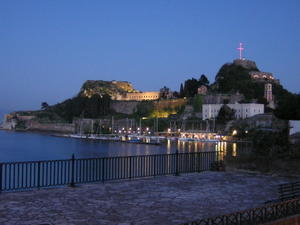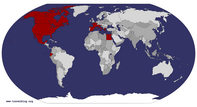Advertisement
Published: November 10th 2006

 Corfu
Corfu
Corfu, Kerkyra - GreeceOct 3, 1993
*
City official name :Corfu
*
Founded date : *
Location :Kerkyra Prefecture
*
Elavation :? ft (? m)
*
Area :Approximately ? square miles (? km²).
*
Facts :Corfu (Greek: Κέρκυρα - Kérkyra) is a city in north-western Greece. It is the capital and main town of the island and prefecture of Corfu.
According to the local tradition Corcyra (Κόρκυρα) was the Homeric island of Scheria (Σχερία), and its earliest inhabitants the Phaeacians (Φαίακες). At a date no doubt previous to the foundation of Syracuse it was peopled by settlers from Corinth, but it appears to have previously received a stream of emigrants from Eretria. The splendid commercial position of Corcyra on the highway between Greece and the West favoured its rapid growth and, influenced perhaps by the presence of non-Corinthian settlers, its people, quite contrary to the usual practice of Corinthian colonies, maintained an independent and even hostile attitude towards the mother city. This opposition came to a head in the early part of the 7th century, when their fleets fought the first naval battle recorded in Greek history (about 664 BC). These hostilities ended in the conquest of Corcyra by the Corinthian tyrant

 Corfu
Corfu
Corfu, Kerkyra - GreecePeriander (Περίανδρος) who induced his new subjects to join in the colonization of Apollonia and Anactorium. The island soon regained its independence and henceforth devoted itself to a purely mercantile policy. During the Persian invasion of 480 BC it manned the second largest Greek fleet (60 ships), but took no active part in the war. In 435 BC it was again involved in a quarrel with Corinth and sought assistance from Athens (see Battle of Sybota). This new alliance was one of the chief immediate causes of the Peloponnesian War, in which Corcyra was of considerable use to the Athenians as a naval station, but did not render much assistance with its fleet. The island was nearly lost to Athens by two attempts of the oligarchic faction to effect a revolution; on each occasion the popular party ultimately won the day and took a most bloody revenge on its opponents (427 BC and 425 BC). During the Sicilian campaigns of Athens Corcyra served as a supply base; after a third abortive rising of the oligarchs in 410 BC it practically withdrew from the war. In 375 BC it again joined the Athenian alliance; two years later it was besieged by

 Corfu
Corfu
Corfu, Kerkyra - Greecea Lacedaemonian force, but in spite of the devastation of its flourishing countryside held out successfully until relieved. In the Hellenistic period Corcyra was exposed to attack from several sides.
In 303 BC after a vain siege by Cassander, the island was occupied for a short time by the Lacedaemonian general Cleonymos, then regained its independence and later it was attacked and conquered by Agathocles. He offered Corfu as dowry to his daughter Lanassa on her marriage to Pyrrhus, King of Epirus. The island then became a member of the Epirotic alliance. It was then perhaps that the settlement of Cassiope was founded to serve as a base for the King of Epirus' expeditions. The island remained in the Epirotic alliance until 255 BC when it became independent after the death of Alexander, last King of Epirus. It subsequently fell into the hands of Illyrian corsairs, until in 229 BC it was delivered by the Romans, who retained it as a naval station and gave it the rank of a free state. In 31 BC it served Octavian (Augustus) as a base against Mark Antony.
Eclipsed by the foundation of Nicopolis, Kerkyra for a long time passed out

 Corfu
Corfu
Corfu, Kerkyra - Greeceof notice. With the rise of the Norman kingdom in Sicily and the Italian naval powers, it again became a frequent object of attack. In 1081-1085 it was held by Robert Guiscard, in 1147-1154 by Roger II of Sicily. During the break-up of the Later Roman Empire it was occupied by Genoese privateers (1197-1207) who in turn were expelled by the Venetians. In 1214-1259 it passed to the Greek despots of Epirus, and in 1267 became a possession of the Neapolitan house of Anjou. Under the latter's weak rule the island suffered considerably from the inroads of various adventurers; hence in 1386 it placed itself under the protection of Venice, which in 1401 acquired formal sovereignty over it.
Kerkyra remained in Venetian hands till 1797, though several times assailed by Turkish naval and land forces and subjected to four notable sieges in 1537, 1571, 1573 and 1716, in which the great natural strength of the city and its defenders asserted itself time after time. The effectiveness of the Venetian fortifications of the island was another great factor that enabled Corfu to remain the last bastion of free, uninterrupted Greek civilization after the fall of Constantinople.
There were many

 Corfu
Corfu
Corfu, Kerkyra - Greeceattempts by the Turks to take the island starting as early as 1431 when Turkish troops under Ali Bey landed on the island, tried to take the castle and raided the surrounding area, but were repulsed.
This was the first great siege by the Turks. It started on the 29th August 1537 with 25,000 soldiers from the Turkish fleet landing and pillaging the island and taking 20,000 hostages as slaves. Despite the destruction wrought on the countryside, the city castle held out in spite of repeated attempts over twelve days to take it, and the Turks left the island unsuccessful because of poor logistics and an epidemic that decimated their ranks.
34 years later in August of 1571 the Turks returned for yet another attempt at conquering the island. Having seized Parga and Mourtos from the Greek mainland side they attacked the Paxi islands, killing, looting and burning. Subsequently they landed on Corfu's southeast shore and established a large beachhead all the way from the southern tip of the island at Lefkimi to Ipsos in Corfu's midsection. These areas were thoroughly pillaged and burnt as in past encounters. Nevertheless the city castle stood firm again, a testament to

 Corfu
Corfu
Corfu, Kerkyra - GreeceCorfiot-Venetian steadfastness as well as the Venetian castle-building engineering skills. It is also worth mentioning that another castle, Angelokastro (Greek: Αγγελόκαστρο meaning Angelo's Castle and named for its Byzantine owner Angelos Komnenos), situated on the northwest coast near Palaiokastritsa (Greek: Παλαιοκαστρίτσα meaning Old Castle place) and located on particularly steep and rocky terrain, a tourist attraction today, also held out.
Two years later the Turks repeated their attempt. Coming from Africa after a victorious campaign, they landed in Corfu and wreaked havoc on the countryside yet again. Their troops however were not particularly noted for their discipline, so after a counterattack by the Venetian-Corfiot forces they were forced to leave the city by way of the sea.
This is the second great siege of Corfu which took place in 1716. At that time the Turkish army and naval force led by the great Sultan Achmet III appeared in Butrinto opposite Corfu. On the 8th of July the Turkish fleet carrying 33,000 men sailed to Corfu from Butrinto and established a beachhead in Ipsos. The same day the Venetian fleet encountered the Turkish fleet off the channel of Corfu and defeated it in the ensuing naval battle. On the

 Corfu
Corfu
Corfu, Kerkyra - Greece19th of July the Turkish army reached the hills of the town and laid siege to the city. After repeated failed attempts and heavy fighting, the Turks were forced to raise the siege which had lasted 22 days. The 5000 Venetians and other nationals and 3000 Corfiotes under the leadership of Count Schulenburg who commanded the defence of the island against the Turks loomed tall and victorious once again. Venetian castle engineering had prevailed once more against considerable odds. It can be said that at the time Corfu was the most heavily fortified city in the whole of Europe and provided the model to the rest of Europe, time after time, on how to stem the Ottoman tide. This role that Corfu played as a bastion of Western civilization during Medieval times and beyond is often relatively unknown or ignored. From the Venetian-Corfiote collaboration one can also glimpse from the distant past the seeds of a future European Union, not to forget, naturally, the assistance of Austrian Count Schulenburg.
Venetian policies
The Venetian feudal families pursued a mild but somewhat enervating policy towards the natives, who began to merge their nationality in that of the Latins and adopted

 Corfu
Corfu
Corfu, Kerkyra - Greecefor the island the new name of Corfu. The Corfiotes were encouraged to enrich themselves by the cultivation of the olive, but were debarred from entering into commercial competition with Venice. The island served as a refuge for Greek scholars, and in 1732 became the home of the first academy of modern Greece, but no serious impulse to Greek thought came from this quarter.
By the Treaty of Campo Formio, Corfu was ceded to the French, who occupied it for two years, until they were expelled by the Russian squadron under Admiral Ushakov. For a short time it became the capital of a self-governing federation of the Hephtanesos ("Seven Islands"); in 1807 its faction-ridden government was again replaced by a French administration, and in 1809 it was vainly besieged by a British fleet. When, by the Treaty of Paris of November 5, 1815, the Ionian Islands became a protectorate of the United Kingdom, Corfu became the seat of the British high commissioner. The British commissioners, who were practically autocrats in spite of the retention of the native senate and assembly, introduced a strict method of government which brought about a decided improvement in the material prosperity of the island,

 Corfu
Corfu
Corfu, Kerkyra - Greecebut by its very strictness displeased the natives. In 1864 it was, with the other Ionian Islands, ceded to the kingdom of Greece, in accordance with the fervent wishes of the Corfiotes
During the First World War, the island served as a refuge for the Serbian army that retreated there by the allied forces ships from the homeland occupied by the Austrians. During their stay, a large portion of Serbian soldiers died from exhaustion, food shortage, and different diseases. Most of their remains were buried at the sea near the island of Vido, a small island at the mouth of Corfu port, and a monument of thanks to the Greek Nation has been erected at Vido by the grateful Serbs; consequently, the waters around Vido island are known by the Serbian people as the Blue Graveyard (in Serbian, Plava Grobnica).
In the Second World War, the Italian Army bombarded the city, devastating most of the area. After the Battle of Greece was over, Corfu came under Italian control. Upon the fall of Italian fascism in 1943, the Nazis took control of the island. Corfu's mayor at the time, Kollas, was a known collaborator and various anti-semitic laws were

 Corfu
Corfu
Corfu, Kerkyra - Greecepassed by the Nazis that now formed the occupation government of the island. In early June 1944, while the Allies bombed Corfu as a diversion from the Normandy landings, the Gestapo rounded up the Jews of the city, temporarily incarcerated them at the old fort (Palaio Frourio), and on the 10th of June sent them to Auschwitz where very few survived. Approximately two hundred out of a total population of 1900 escaped. Many among the local population at the time provided shelter and refuge to those 200 Jews that managed to escape the Nazis. A prominent section of the old town is to this day called Evraiki (Εβραική, meaning Jewish quarter) in recognition of the Jewish contribution and continued presence in Corfu city. An active Synagogue (Συναγωγή) with about 65 members is an integral part of Evraiki.
Advertisement
Tot: 0.118s; Tpl: 0.012s; cc: 13; qc: 27; dbt: 0.0753s; 1; m:domysql w:travelblog (10.17.0.13); sld: 1;
; mem: 1.1mb












